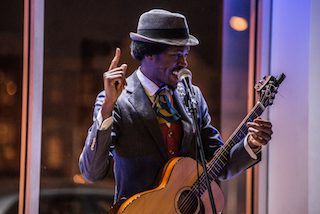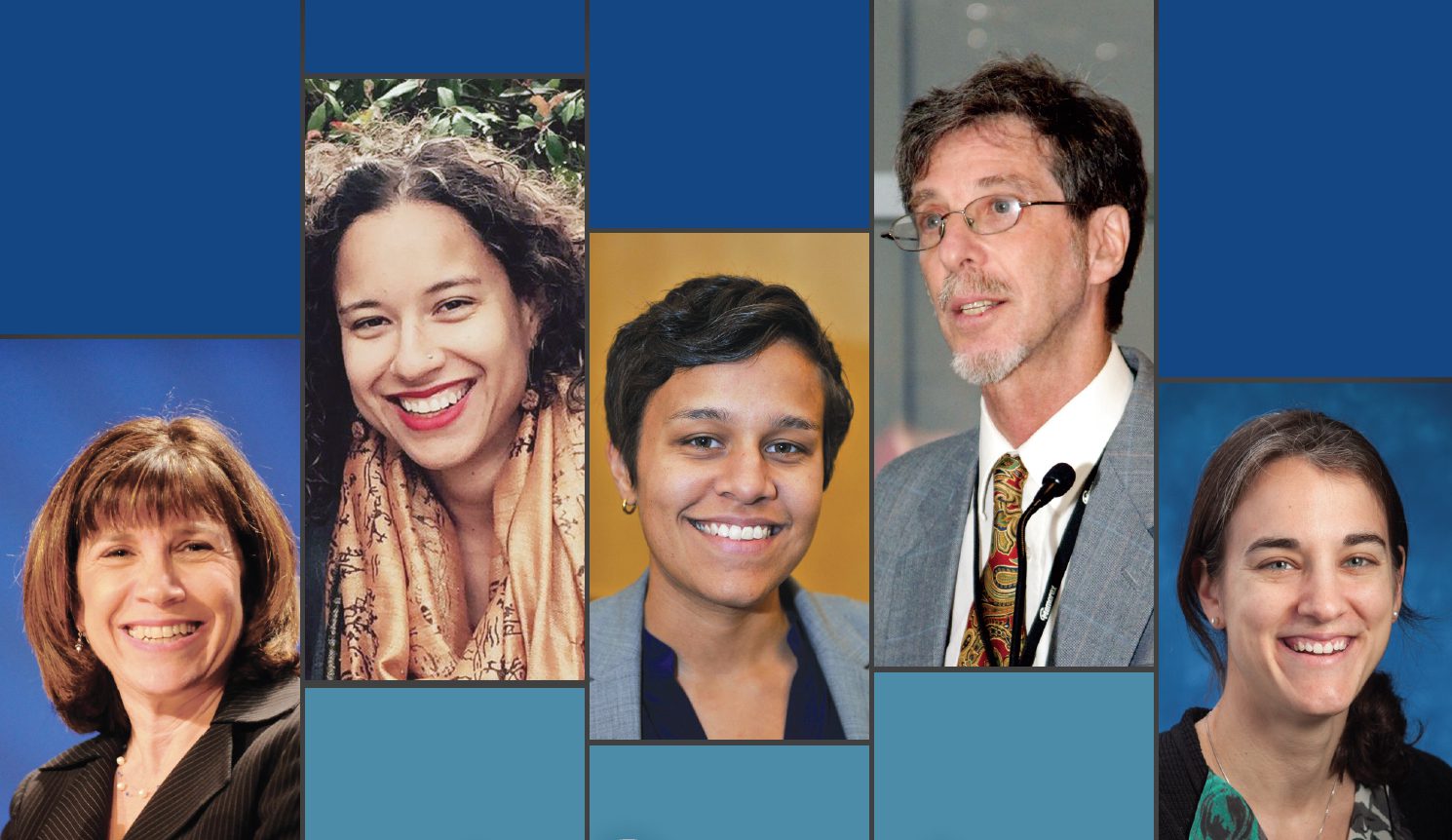
Progressive hip-hop artist Christylez Bacon performs at the Anacostia Arts Center. Photo courtesy of StereoVision
Anacostia is one of Washington, D.C.’s most storied regions. Located east of the Anacostia River, it includes the Anacostia Historic District, which has been part of the National Register of Historic Places since 1978. Within its borders is the Frederick Douglass National Historic Site, named for the famous abolitionist, and in the 1800s, it was home to much of Washington, D.C.’s working class.
Yet time has not been kind to the neighborhood. Despite its rich legacy, Anacostia is home to many of the capital’s most impoverished residents. A 2015 Urban Institute study found that of the 28 neighborhoods in the District of Columbia that are classified as “economically challenged,” 22 of them are located east of the Anacostia River.
For the people of Anacostia, that means little opportunity for economic development. Even though the U.S. Capitol is less than 3 miles away, for years, it has been nearly impossible to find a variety of sit-down restaurants and retail establishments in Anacostia. As a result, residents have had few recreational outlets and sources of employment.
However, while some viewed Anacostia through the lens of what it didn’t have, others looked at it through rose-colored glasses, envisioning what it could become. If Anacostia became a destination place, it could attract people from the more well-heeled parts of the District, as well as the surrounding suburbs in Virginia and Maryland, says Duane Gautier, president and CEO of ARCH Development Corp., an organization focused on revitalizing Anacostia using the arts and creative economy. The idea was, if people had a reason to come to Anacostia, they would spend money there, and that would entice other businesses to set up shop in the community.
Creating a Cultural Destination
With that idea in mind, ARCH Development Corp. set out to get it done. One of the first things it did in 2007 was open the Honfleur Gallery with an exhibition on tattoos. “People thought we were absolutely crazy,” says Gautier. “There had never been an art gallery in Anacostia that anybody could remember going back to the ’50s, and we bought this old building, and renovated it.” Local newspapers trashed the exhibit, and the idea of an art gallery in Anacostia altogether, thinking there was no way such an endeavor could thrive in Anacostia.
But not everyone agreed. The Washington City Paper gave the gallery favorable coverage, and people began to hear about it via word of mouth and social media. Over time, more and more residents of Washington, D.C. and the surrounding areas began to visit.
ARCH discovered that Anacostia was home to a large number of photographers, so it opened a photography gallery called Vivid Solutions. The corporation also realized that in recent years, the Anacostia neighborhood experienced an influx of young professionals and artists, perhaps because rents were more affordable there than in other parts of the District.
While the neighborhood has not become an artistic hub overnight, today ARCH Development Corp. operates four units of artist housing; it hosts the annual LUMEN8ANACOSTIA, a festival of lights, art, and music that takes place along Historic Anacostia’s commercial corridor; and it has set up a Creative Incubator that helps the creative community and other small businesses maintain and grow their businesses. It is also in the process of developing the Anacostia Arts Center, a project that will provide a 1,000-square-foot Black Box Theater, three designer clothing boutiques, a yoga studio, an art gallery, a café, and an 800-square-foot lounge area. In 2016, the arts center will host two resident theater companies and present at least 90 performances, as well as weekly music, spoken word, “improv,” and burlesque events.
The naysayers who laughed at the idea of an art gallery in Anacostia now see how the district is becoming a place where the local art community thrives, and economic development is also improving with the addition of restaurants such as Busboys and Poets, a community gathering place that has several D.C. locations. While many factors have contributed to the improvements in Anacostia, residents are now seeing ARCH Development Corp. as a major contributor to the shift. “We see ourselves as a catalyst,” Gautier says. “I love the art community all over D.C., but I really care most about Anacostia.”
ARCH Development Corp.’s efforts to bring art to Anacostia exemplify how neighborhoods across the country have benefited from similar endeavors. Using the arts as a catalyst for change “works because the arts are a unique fuel for civic vitality,” says Kelly J. Barsdate, chief program and planning officer for the National Assembly of State Arts Agencies, a professional association that advocates for the country’s state and jurisdictional arts agencies.
The arts can literally transform a community, Barsdate says. “The arts create a welcoming sense of place and a desirable quality of life. That in turn helps you have a strong resident community, and cultural and civic character, and engagement. It helps the community attract and attain young people who can envision a future for themselves. It helps to attract and retain businesses. It stimulates commerce. It’s a magnet for tourism, so that’s bringing in other people’s money, which is even better than recirculating your own.”
A Budding Conversation
The discussion surrounding the arts as an avenue for community revitalization has been gaining more traction in recent years. The National Endowment for the Arts, a federal agency charged with encouraging arts participation in communities throughout the country, has played a major role in that.
A guiding principal in the agency’s strategic plan is “Art Works,” which acknowledges that a flourishing artistic community spends money and pays taxes, contributing to the economic growth of cities and towns across the country. As the largest funder of nonprofit arts in the United States, the NEA gives away more than $130 million a year through grants and cooperative agreements. In fact, an NEA grant will support ARCH Development Corp.’s efforts to create an artist residency program and exhibition series. As part of the program, two artists will be selected to create site-specific installations inside the Anacostia Arts Center.
The creation of ArtPlace America, a consortium of federal agencies, foundations, and financial institutions that focus on creative placemaking, has also made a difference. ArtPlace works to promote the idea that art must play an integral role in community planning and development, because it’s as much a part of a healthy community as housing and transportation.
ArtPlace has come up with four qualities that successful creative placemaking projects have:
- They define a specific geographic location, such as a block, city or neighborhood.
- They outline a change that people living in that location would like to see.
- They come up with an arts-based solution to help create that change.
- They create an accountability system that tracks whether the change has occurred.
These national efforts have helped lay a foundation for state and local arts agencies to actively engage in programs that are community-based. Every state arts agency has a community development coordinator, and many agencies have grant programs that are specifically designed to fund community-based art projects. For example, some states have created cultural districts, which are intended to increase economic development in certain areas by bringing together an artistic community around a specific place.
While it’s easy to think of New York and San Francisco as cultural hubs, creative placemaking calls on community developers to think about all areas as being able to benefit from an artistic community. That means every type of neighborhood from the big city to the suburbs and to Main Street USA.
“It’s a really a powerful magnetic catalyst that brings together all those other pieces of a community’s infrastructure,” Barsdate says. “The building environment, the social environment, the transportation infrastructure, the character of public space—all of that is indelibly shaped, not just by physical art but by the energy around art and the presence of art-making and art-makers in a community.”
Empowering Artistic Businesses
Another organization that recognizes the power of the arts is St. Louis, Missouri–based UrbArts. Founded in August 2001 by poet MK Stallings, UrbArts promotes arts, education, economics, and social services. UrbArts has found that empowering artists is an opportunity to transform the lives of residents in the St. Louis area.
Not only does the organization seek to bring audiences into North St. Louis that otherwise wouldn’t visit the area, but it also helps artists improve their own financial and business opportunities. When artists are thriving, they, in turn, can pump more dollars into the local economy.
“There are a lot of artists who just simply don’t know business,” Stallings says. “They know their art, but they don’t necessarily know how to maximize income.” For example, some artists might not think about ways to fully use the space where an event is being held in order to sell T-shirts, paintings, or prints. By selling items in addition to performing, they can create additional revenue streams. “To that degree, we also function as an artist incubator, telling them about the things that they need to know, things that they need to think about,” says Stallings.
UrbArts hosts several art exhibitions per year where it sells work on behalf of the artists, retaining 20 percent of the profits while the artists receive the rest. The organization also gives teaching contracts to artists. But UrbArts’ work doesn’t end there.
“We assist in promotional efforts for the artists. We do as much coaching as we can, without any fee whatsoever,” Stallings says. “We provide a hub or a way to link artists who are interested in selling their work. We record spoken-word CDs for the poets that come through our space. We do a lot of stuff.”
The organization also helps artists build a national platform. UrbArts’ spoken-word artists and poets participate in a poetry slam, and winners are sent to a national competition. But recognizing that it might be challenging for some artists to raise the money to travel to the competition, UrbArts holds fundraisers to come up with the funds that can go toward buying plane tickets, and paying for housing and registration fees. “Those are all things that we can leverage because we’re an organization, and we have a presence and we have a location, where the individual artist would have to try to partner with somebody just to be able to make those things happen,” Stallings says.
ARCH has also helped creative entrepreneurs with the financial aspects of running a business. One of the biggest challenges small business owners face is funding. To help alleviate that problem, in 2014, the organization began The Kresge Foundation Loan Fund for Artists, Art Organizations, and Hive Creative Industry Businesses. The fund provides loans for entrepreneurial efforts among Anacostia’s creative community. Through its Creative Incubator, called Hive 2.0, ARCH also provided local business owners with some of the technical support they need to be successful, whether it’s access to office equipment, administrative support, or even accounting help.
Revitalization Through Culture
Art can also be used to maintain, and even increase, a neighborhood’s cultural value.
San Francisco is home to the largest Chinatown outside of the continent of Asia. It’s also the oldest Chinatown in North America, so its legacy is, indeed, rich. To ensure that the community remains a cultural jewel, the Chinatown Community Development Center assists with community advocacy, planning, and affordable housing development in that neighborhood. One way it does this is by focusing on the arts.
“Chinatown is a neighborhood with a lot of history and culture,” says Roy Chan, community planning manager for the Chinatown Community Development Center. “A lot of art making, or culture making happens organically in our open spaces, it happens by the customs and celebrations, and the traditions that are honored throughout the year. The way we think of working with artists is through that lens of really thinking of everyday people as culture makers and artists.”
To that end, the organization worked with local artists to develop place-based exhibitions. For example, “Chinatown Pretty,” an exhibition created by artists Andria Lo and Valerie Luu, is a blog and a series of portraits that celebrate the street style of seniors who live in San Francisco’s Chinatown area. Another exhibit created by Lo and Luu, “Shop Chinatown,” complements efforts to get more people to spend their money in the retail district.
“We kind of stumbled upon two young artists that were profiling all the generations. It was kind of neat to see how local artists are emerging in the neighborhood, and how by providing a platform for them, we’ve been able to really showcase their work in different ways,” Chan says.
The Chinatown Community Development Center also provides space for the arts community. “A year and a half ago we worked with a property owner to activate a space in one of the oldest alleys of the neighborhood,” Chan says. “It’s sort of an interactive art and culture space. Since then, we’ve been able to showcase local artists’ work at the space, from photographers, to artists working with youth to interpret their stories. This way we have been able to showcase that work, and also activate the alley.”
The community has benefited greatly from the organization’s work. For one thing, artists have been given a platform to showcase their work in a city that is becoming increasingly unaffordable for artists, Chan says. Secondly, the artists’ work reflects the community and reaffirms the everyday culture of the neighborhood.
Another community that is using art to reaffirm its culture is St. Clair Superior, a diverse and historic section of Cleveland. The St. Clair Superior Development Corporation works to revitalize both the residential and business communities, and uses creative placemaking to do so.
One of the keys to a thriving local economy is attracting new businesses. However, getting businesses to come to Cleveland is not enough. Those businesses must be able to sustain themselves and grow. The St. Clair Superior Development Corporation has started several entrepreneurship programs to develop and support local startups as well as legacy businesses in the community, says Executive Director W. Michael Fleming.
The corporation has also supported local artists and business owners by creating highly successful marketplaces including the Cleveland flea and AsiaTown night markets. It also supports the QuARTer Arts District, an area of galleries and artist lofts. Not only does the district give the city’s artists a place to convene, but it serves as a means to revive some of the historic industrial buildings in downtown Cleveland.
The organizations that are looking to spark change recognize that supporting artists creates a win-win for both the local art community and the economic strength of the surrounding area. “Art is truly a gateway to greatness,” Barsdate says.





Comments